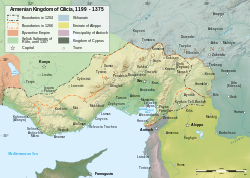
Back Reino d'Armenia la Chica AN مملكة أرمينيا الصغرى Arabic مملكة كيليكيا ARZ Reinu armeniu de Cilicia AST Kilikiya çarlığı Azerbaijani کیلیکی ائرمنی چارلیغی AZB Кілікійскае царства Byelorussian Киликийско арменско царство Bulgarian Regne Armeni de Cilícia Catalan Arménské království v Kilíkii Czech
37°00′N 35°30′E / 37.0°N 35.5°E
Armenian Principality of Cilicia (1080–1198) Armenian Kingdom of Cilicia (1198–1375) Կիլիկիոյ Հայոց Թագաւորութիւն | |||||||||||||||||
|---|---|---|---|---|---|---|---|---|---|---|---|---|---|---|---|---|---|
| 1198/99–1375 | |||||||||||||||||
Flag of the Rubenid dynasty (1198–1219)
| |||||||||||||||||
 | |||||||||||||||||
| Status | Independent principality (1080–1198) Kingdom (1198–1375) | ||||||||||||||||
| Capital | Tarson (Tarsus, Mersin) (1080–1198) Sis (Kozan, Adana) (1198–1375) | ||||||||||||||||
| Common languages | Armenian (native language), Latin, Old French, Italian, Greek, Syriac | ||||||||||||||||
| Religion | Christianity (Armenian Apostolic, Armenian Catholic)[1] | ||||||||||||||||
| Government | Feudal monarchy | ||||||||||||||||
| Historical era | Middle Ages | ||||||||||||||||
• Prince Leo II crowned as King Leo I | January 6, 1198/99 | ||||||||||||||||
• Tributary to the Mongols | 1236 | ||||||||||||||||
| 1375 | |||||||||||||||||
| Area | |||||||||||||||||
| 13th century[2] | 40,000 km2 (15,000 sq mi) | ||||||||||||||||
| Population | |||||||||||||||||
• 13th century[2] | 1,000,000+ | ||||||||||||||||
| |||||||||||||||||
| Today part of | Turkey Syria Cyprus | ||||||||||||||||
| History of Armenia |
|---|
 |
| Timeline • Origins • Etymology |
The Armenian Kingdom of Cilicia (Middle Armenian: Կիլիկիոյ Հայոց Թագաւորութիւն, romanized: Kiligio Hayoc’ T’akavorut’iun), also known as Cilician Armenia (Armenian: Կիլիկեան Հայաստան, romanized: Kilikyan Hayastan, or Հայկական Կիլիկիա, Haykakan Kilikia), Lesser Armenia, Little Armenia or New Armenia,[3] and formerly known as the Armenian Principality of Cilicia (Armenian: Կիլիկիայի հայկական իշխանութիւն), was an Armenian state formed during the High Middle Ages by Armenian refugees fleeing the Seljuk invasion of Armenia.[4] Located outside the Armenian Highlands and distinct from the Kingdom of Armenia of antiquity, it was centered in the Cilicia region northwest of the Gulf of Alexandretta.
The kingdom had its origins in the principality founded c. 1080 by the Rubenid dynasty, an alleged offshoot of the larger Bagratuni dynasty, which at various times had held the throne of Armenia. Their capital was originally at Tarsus, and later moved to Sis.[5] Cilicia was a strong ally of the European Crusaders, and saw itself as a bastion of Christendom in the East. It also served as a focal point for Armenian cultural production, since Armenia proper was under foreign occupation at the time. Cilicia's significance in Armenian history and statehood is also attested by the transfer of the seat of the Catholicos of the Armenian Apostolic Church, spiritual leader of the Armenian people, to the region.
In 1198, with the crowning of Leo I, King of Armenia of the Rubenid dynasty, Cilician Armenia became a kingdom.[6][7] In 1226, the crown was passed to the rival Hethumid dynasty through Leo's daughter Isabella's second husband, Hethum I. As the Mongols conquered vast regions of Central Asia and the Middle East, Hethum and succeeding Hethumid rulers sought to create an Armeno-Mongol alliance against common Muslim foes, most notably the Mamluks.[7] In the thirteenth and fourteenth centuries, the Crusader states and the Mongol Ilkhanate disintegrated, leaving the Armenian Kingdom without any regional allies. After relentless attacks by the Mamluks in Egypt in the fourteenth century, the Armenian Kingdom of Cilicia, then under the rule of the Lusignan dynasty and mired in an internal religious conflict, finally fell in 1375.[8]
Commercial and military interactions with Europeans brought new Western influences to the Cilician Armenian society. Many aspects of Western European life were adopted by the nobility including chivalry, fashions in clothing, and the use of French titles, names, and language. Moreover, the organization of the Cilician society shifted from its traditional system to become closer to Western feudalism.[9] The European Crusaders themselves borrowed know-how, such as elements of Armenian castle-building and church architecture.[10] Cilician Armenia thrived economically, with the port of Ayas serving as a center for East–West trade.[9]
- ^ Ghazarian, Jacob (2018). The Armenian Kingdom in Cilicia During the Crusades: The Integration of Cilician Armenians with the Latins, 1080-1393. Routledge. ISBN 9781136124181.
- ^ a b Bornozyan, S. V.; Zulalyan, Manvel [in Armenian] (1976). Հայ Ժողովրդի Պատմություն, Հ. 3. [History of the Armenian People. Vol. 3] (in Armenian). Yerevan: Armenian Academy of Sciences. pp. 672, 724. Archived from the original on 2024-02-08. Retrieved 2024-02-23.
Կիլիկյան հայկական պետության ծաղկան ժամանակաշրջանում՝ XIII դարում, նրա տարածությունը կազմում էր 40.000 քառ. կմ, իսկ բնակչության թիվը անցնում էր մեկ միլիոնից։ [...] Կիլիկիայի քաղաքներում ու նավահանգիստներում էր կենտրոնացված Կիլիկիայի մեկ միլիոն բնակչության համարյա կեսը։
- ^ "Landmarks in Armenian history". Internet Archive. Retrieved June 22, 2010. "1080 A.D. Rhupen, cousin of the Bagratonian kings, sets up on Mount Taurus (overlooking the Mediterranean Sea) the kingdom of New Armenia which lasts 300 years."
- ^ Der Nersessian, Sirarpie (1969) [1962]. "The Kingdom of Cilician Armenia". In Setton, Kenneth M.; Wolff, Robert Lee; Hazard, Harry W. (eds.). A History of the Crusades, Volume II: The Later Crusades, 1189–1311 (Second ed.). Madison, Milwaukee, and London: University of Wisconsin Press. pp. 630–659. ISBN 0-299-04844-6., pp. 630–631.
- ^ Edwards, Robert W. (1987). The Fortifications of Armenian Cilicia, Dumbarton Oaks Studies No.23. Washington D. C.: Dumbarton Oaks, Trustees for Harvard University. pp. vii–xxxi, 3–288. ISBN 0884021637.
- ^ Kurdoghlian, Mihran (1996). Պատմութիւն Հայոց [History of Armenia] (in Armenian). Vol. II. Athens: Հրատարակութիւն ազգային ուսումնակաան խորհուրդի [Council of National Education Publishing]. pp. 43–44.
- ^ a b Cite error: The named reference
A History of the Crusades 2was invoked but never defined (see the help page). - ^ Cite error: The named reference
Ghazarianwas invoked but never defined (see the help page). - ^ a b Cite error: The named reference
The Armenian People From Ancient to Modern Timeswas invoked but never defined (see the help page). - ^ Cite error: The named reference
Architecturewas invoked but never defined (see the help page).

